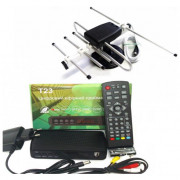Overclocked: a history of violenceoverclocked. оправданная жестокость
Содержание:
- Nvidia Mining on Kawpow
- Есть ли в Overcooked! 2 кроссплей?
- OC Strategy #3: AI Overclocking
- Intel Rocket Lake Overclocking Expectations
- Overclocking to 2.2 GHz
- Intel Core i5-11600K: Platform Overview
- Cookie Run: Kingdom The Best Team Состав
- AMD RX 5ххх and 6ххх Overclocking for Mining
- Raspberry Pi 2 gpu_mem (1GB memory) allocation
- Free Updates[]
- Intel Rocket Lake Overview
- Features[]
- Energy Efficiency in Mining. Operating modes
- Introduction
- Description[]
- Raspberry Pi 2 Overclock options
- Thermal Performance at 1.8 GHz
- Other ways to play with friends
- OC Strategy #1: Unlocked the Power Limits & XMP
Nvidia Mining on Kawpow
Kawpow algorithm with RVN as the main cryptocurrency entered the mining industry with a boom. The Ravencoin hash rate table below demonstrates the growth in popularity. The hash rate in the 2Miners pool has increased 5 times in a month.
At the same time RVN price increased by 500% in 40 days. On February 20, 2021, it set the record of 28.5 cents.

The algorithm works even with 3GB GPUs, adjusts well (many GPUs that are problematic on other algorithms work well on kawpow), and speed correlates to GPU PL. Furthermore, RVN is featured on many major exchanges.
If you look at all the factors, the algorithm comes second best in terms of prominence and profitability in GPU mining after Ethash.

Windows 10 requires GPUs with at least 4 GB of RAM. For Windows 7 and Rave OS 3 GB of RAM is still enough.
GPU Overclocking for Kawpow
Setting up GPUs for Kawpow is quite easy.
- First, we should identify the max memory clock at +25 MHz intervals. Find the clock value that makes the GPU driver crash, move 50 MHz down to the stable area.
- Find the core voltage that will give you the desired GPU energy consumption. Lower voltage results in lower consumption, but also in lower max hash rate. Relationship is not proportional. When you lower the consumption by 25–35% from standard, the speed decreases only by 15–20%. This gives us a unique opportunity to schedule for GPUs to overclock automatically at the best time for multi-rate meters.
- Find the max stable core clock (at +25 MHz intervals), move 25 MHz down from it.

Fine tuning would give us additional 2–6% of hash rate or 2–4% of energy efficiency. We will not go into more detail in this article.
Есть ли в Overcooked! 2 кроссплей?
Базовая игра Overcooked! 2 имеет очень ограниченный кроссплей. Те, кто играет в Steam и Epic Games Store, могут играть вместе на ПК до четырех игроков. Пользователи консолей PS4, Xbox и Switch не могут играть с друзьями в Overcooked! 2 в кроссплатформенном режиме.
До недавнего времени игра для всей семьи не поддерживала кроссплей ни на одной платформе, но она получила обновление, когда ее бесплатно раздавали в Epic Games Store. Однако бесплатная раздача и поддержка кроссплея создали множество проблем для PC-версии, и потребовался откат, чтобы сделать PC-версию снова пригодной для игры с друзьями.
Это уже не первый случай ошибки многопользовательской игры в Overcooked!, но Crossplay по-прежнему доступен для тех, кто хочет включить его в Steam и Epic Games Store, если у них нет проблем с этой функцией.
Игроки Overcooked! 2 на Game Pass PC не могут играть со своими друзьями на PC. Overcooked! All You Can Eat не входит в услугу подписки, а оригинальная игра не имеет кроссплатформенной поддержки в магазине Microsoft.
Другие способы игры с друзьями
Хотя владельцы консолей PlayStation, Xbox и Nintendo не могут играть с друзьями на других консолях, они могут играть по сети в кооперативном режиме со всеми, кто владеет игрой Overcooked! на той же консоли, что и они.
Кроме того, в Overcooked! 2 можно играть локально с четырьмя людьми, если у них достаточно контроллеров. В игре также есть функция, позволяющая двум людям управлять двумя разными персонажами с помощью одного контроллера. У пользователей Switch уже есть два контроллера с джойконами, поэтому эта функция, к сожалению, не предусмотрена в Pro Controller или Switch Lite.
Игроки могут даже объединить сетевой и локальный кооператив, чтобы играть с теми, кто живет с ними в одном доме, и с друзьями в других местах.
Будет ли добавлена поддержка совместной игры?
Ghost Town Games показали, что добавление кроссплатформенной игры не исключено, с новой поддержкой кроссплатформенной игры между Steam и Epic Games Store. Однако, похоже, что это было сделано для поддержки игры, пока она была бесплатной на витрине Epic.
С выходом Overcooked! All You Can Eat с ее функциями кроссплатформенной игры, кажется маловероятным, что студия вернется к добавлению кроссплатформенной поддержки в консольную версию. Однако также маловероятно, что студия добавит поддержку между игроками на ПК, поэтому все еще возможно, что кулинарный симулятор может получить кроссплейное обновление. Однако нет никаких признаков того, что это произойдет в ближайшее время.
Overcooked! 2 — это игра, которой лучше всего наслаждаться с друзьями, поэтому тем, кто хочет воспользоваться преимуществами совместной игры, скорее всего, придется перейти на более доступное издание All You Can Eat, чтобы играть с друзьями и семьей на других платформах.
OC Strategy #3: AI Overclocking
Our third overclocking strategy utilizes the ASUS AI Overclocking feature.
ASUS AI Overclocking is a novel approach to automatic overclocking. Rather than the engineers programming a couple of fixed overclock settings as options in the BIOS, AI overclocking attempts to work out the best overclock settings on its own. It does this by evaluating the quality of your processor and your cooling solution. Based on this evaluation, the proprietary algorithm will adjust the CPU frequency and voltages.
The process of enabling AI overclocking is very simple. First, boot up the system with default settings into the operating system. Then, run a couple of heavy workload benchmarks like Cinebench, Realbench, or Prime95. After about 30 minutes the system will have collected sufficient data on your cooler and CPU. Then, return to the BIOS and simply enable AI overclocking. That’s it!
In our case, AI overclocking set the single core OC to 5 GHz and the all-core OC to 4.7 GHz. So, a 100 MHz bump from default maximum boost frequencies.
Upon entering the BIOS
- Go to the Extreme Tweaker menu
- Set AI Overclock Tuner to XMP I
- Set ASUS MultiCore Enhancement to Enabled – Remove All Limits
- Set CPU Core Ratio to AI Optimized
Then save and exit the BIOS.
We re-ran the benchmarks and checked the performance increase compared to stock operation.
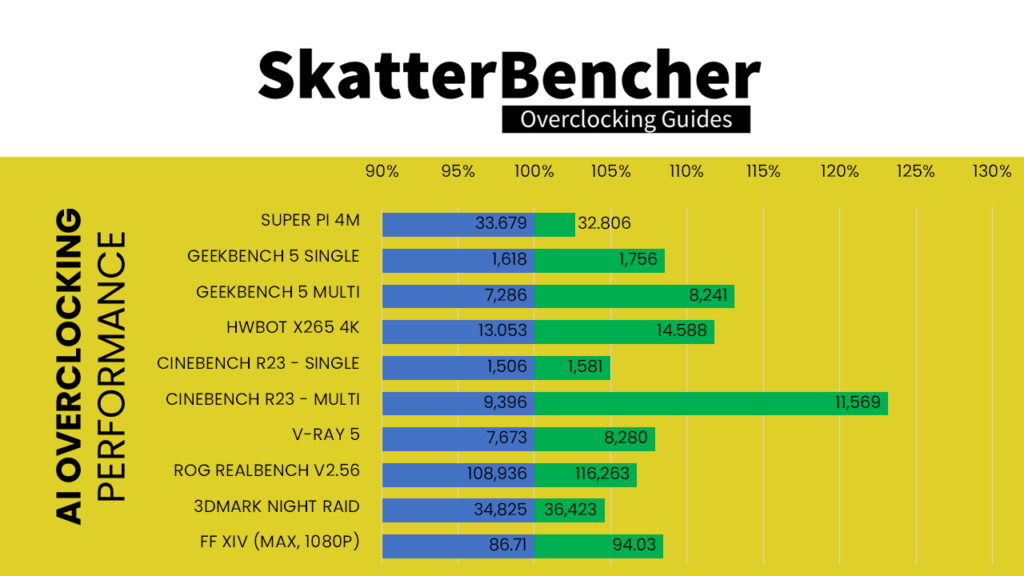
As you can see, the performance increases across the board. However, in all-core multi-threaded applications we find the performance to be lower than our second strategy with package temperature threshold due to the lower frequency.

When running Prime 95 Small FFT with AVX enabled, the Core i5-11600K operates stably at 4.7GHz with 1.351 volt. The average CPU temperature is 89 degrees centigrade, the average VRM temperature is 43 degrees centigrade, and the average water temperature is 25 degrees centigrade. The average CPU package power is 241 watt.
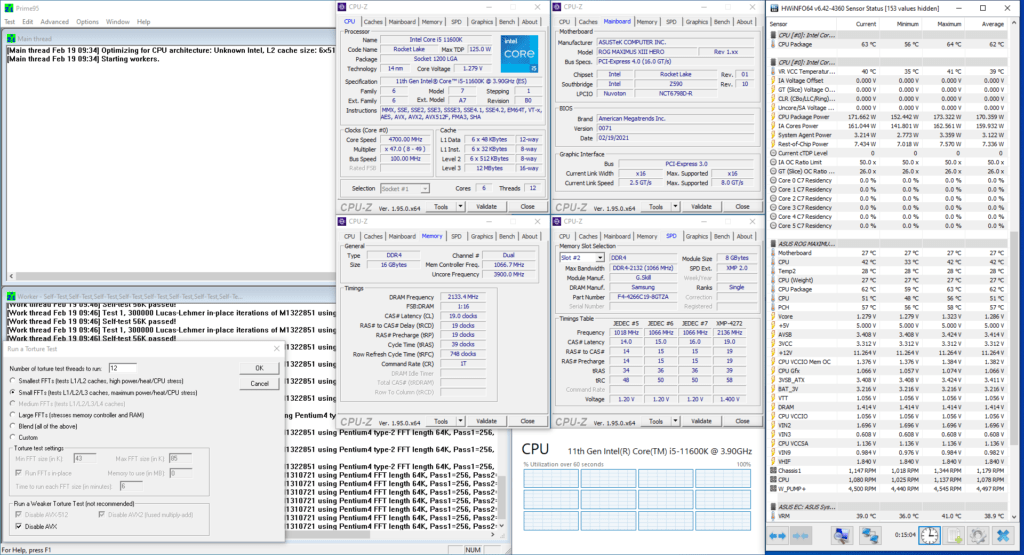
When running Prime 95 Small FFT with AVX disabled, the Core i5-11600K operates stably at 4.7 GHz with 1.286 volt. The average CPU temperature is 62 degrees centigrade, the average VRM temperature is 39 degrees centigrade, and the average water temperature is 27 degrees centigrade. The average CPU package power is 170 watt.
Intel Rocket Lake Overclocking Expectations
In terms of the overclocking expectations we can split it up in two parts: ambient cooling and extreme cooling.
| 1 core max stable | 8 core max stable | 8 core max w/ AVX stable | Ring max stable | Memory max stable | |
| Ambient | 5500 | 5100 | 4800 | 4400 | DDR4-6133 |
| Extreme | 7000 | 6500 | 6400 | 6700 | DDR4-7000 |
For ambient overclocking, I expect the following maximum overclocking results when using high-end custom loop water cooling.
- 5.5 GHz for 1-core maximum stable frequency
- 5.1 GHz for all-core maximum stable frequency
- 4.8 GHz for all-core AVX maximum stable frequency
- 4.3 GHz for maximum stable ring frequency
- DDR4-6133 for maximum stable memory frequency
This is almost the overclock that I managed during one of my early recorded test sessions.
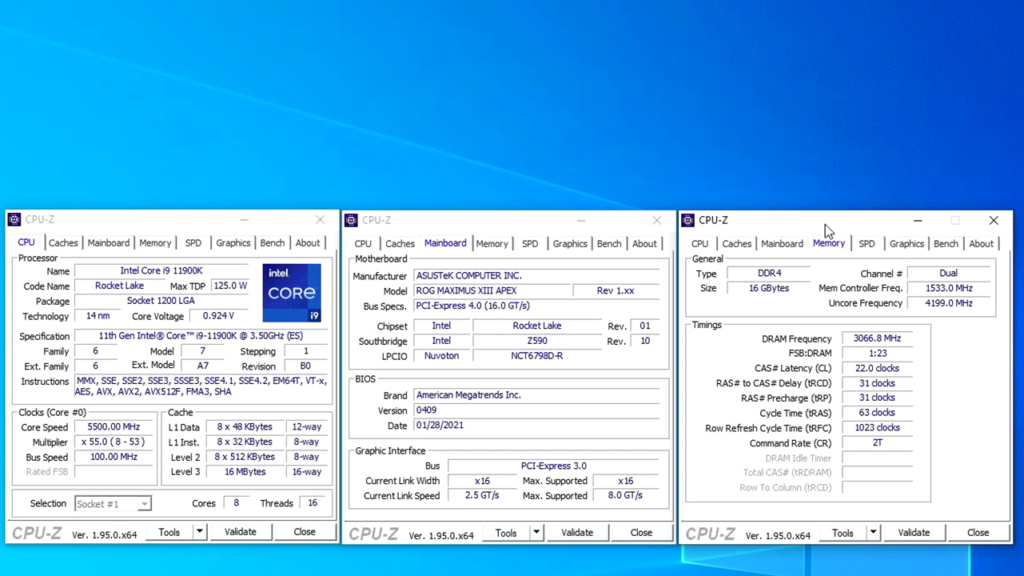
So, compared to Comet Lake:
- Similar single core frequency range
- 100MHz less for all core frequency
- 200 MHz less for all core with AVX frequency
- 300-400 MHz less for the ring frequency
- Vastly improved memory frequency capabilities
These overclocking margins are also in line what we can see for extreme overclocking.
To end this article with I’d like to share with you the Rocket Lake CPU Frequency record set by the ASUS ROG team last month. As is tradition, they used liquid helium to squeeze the most out of a new CPU architecture on launch day. The team consisted of Elmor from ElmorLabs, Shamino from ASUS ROG, and SafeDisk also from ASUS ROG.
While Elmor focused on obtaining the CPU Frequency validation, SafeDisk ran a series of benchmarks with liquid helium. In the end, they pushed the Core i9-11900K past 7.3 GHz with all eight cores enabled.
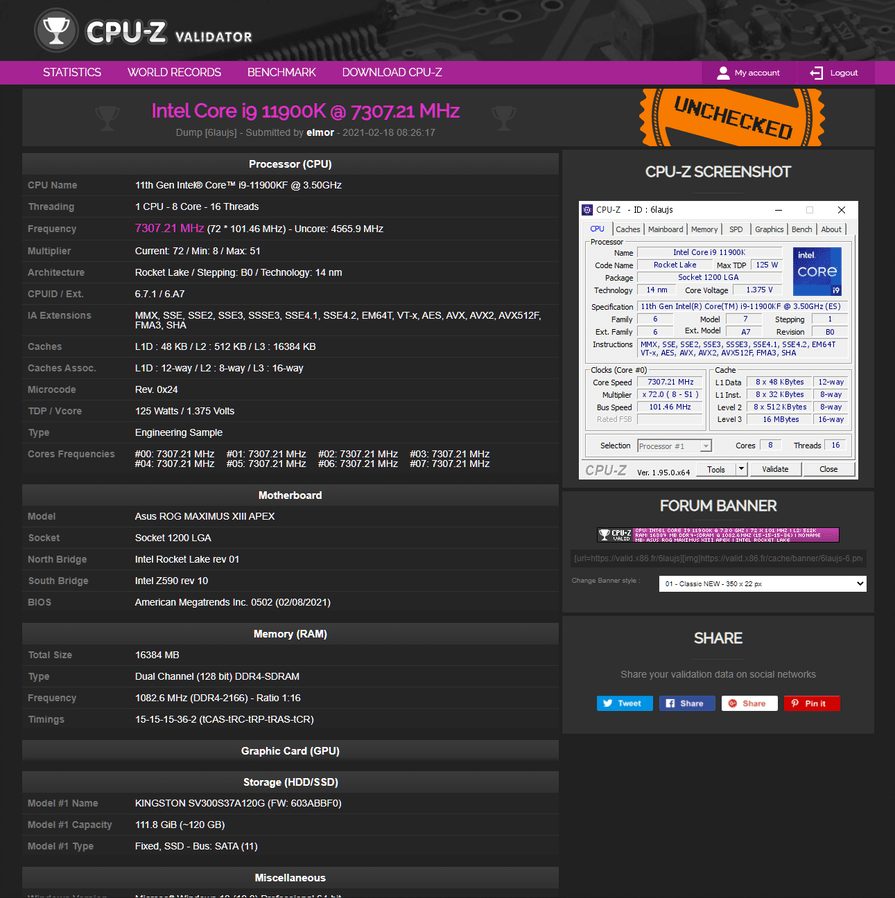
I won’t describe all the footage but I’ll try to annotate the video to give you a little more insight in how a liquid helium session works. I hope you enjoy the bonus footage. As per usual, if you have any questions or comments, feel free to drop them in the comment section below.
Overclocking to 2.2 GHz
So… the Pi 400 is the first Pi I’m able to reliably run at more than 2.147 GHz. After reading this Tom’s Hardware review of the Pi 400, I noted that Les Pounder was able to get the chip to run at 2.2 GHz.
My first attempt to overclock to 2.147 GHz, by setting the following in , resulted in a Pi that would only boot halfway then get locked up:
If could set successfully, but I figured I should go big or go home. I figured it was a power issue, and to set higher than 6, I had to set .
And now it booted up and ran at 2.2 GHz, just like in the Tom’s Hardware review!
I ran the same test for a full 30 minutes, and here’s the temperature graph:
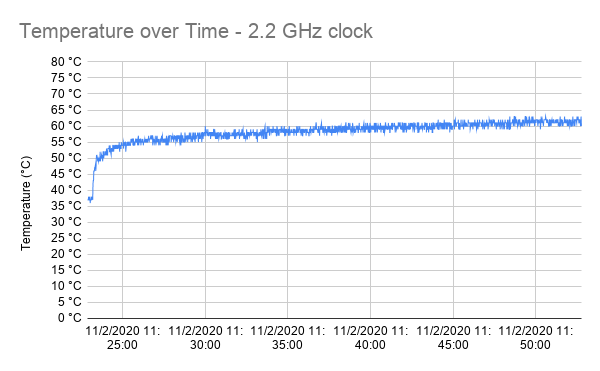
It reached a peak of 63°C, which is still well under the throttling temperature. For comparison, check out the same graph from my overclocked benchmarks on the Compute Module 4, with a massive fan (but no heat sink):
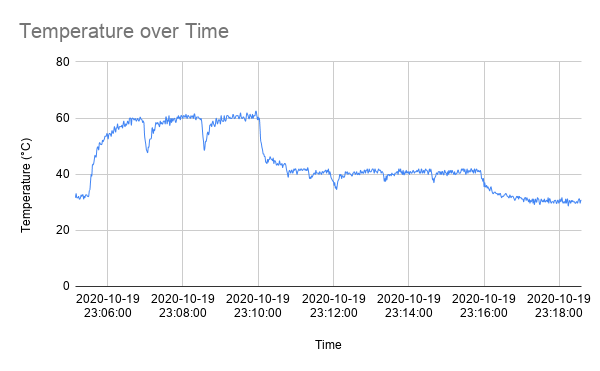
And without a fan, the CM4 behaves like a Pi 4 model B, and reaches 75°C and beyond, throttling the CPU after a while. It’s great to see the passively-cooled Pi 400 can keep from throttling, even overclocked to 2.2 GHz!
Here’s a thermal image after 30 minutes of at 2.2 GHz:
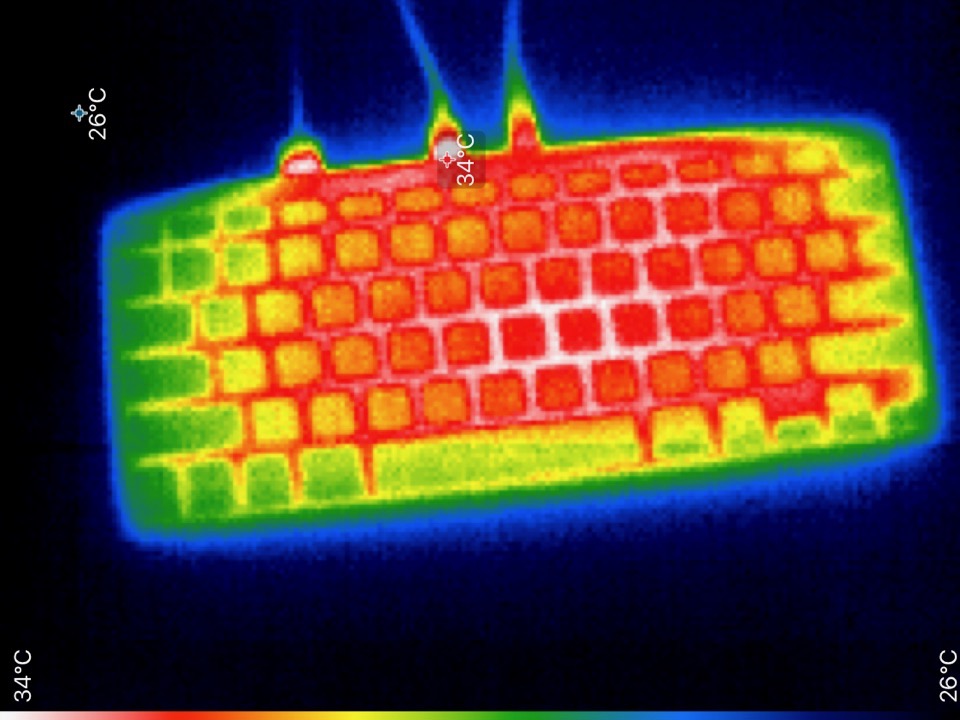
The top was very slightly warm, though still not an issue at all. The bottom was noticeably warm now, like the back of my phone when I use it to watch some streaming videos for a while, but not uncomfortably so. The ports on the back still showed the highest external temps overall, at 42°C:
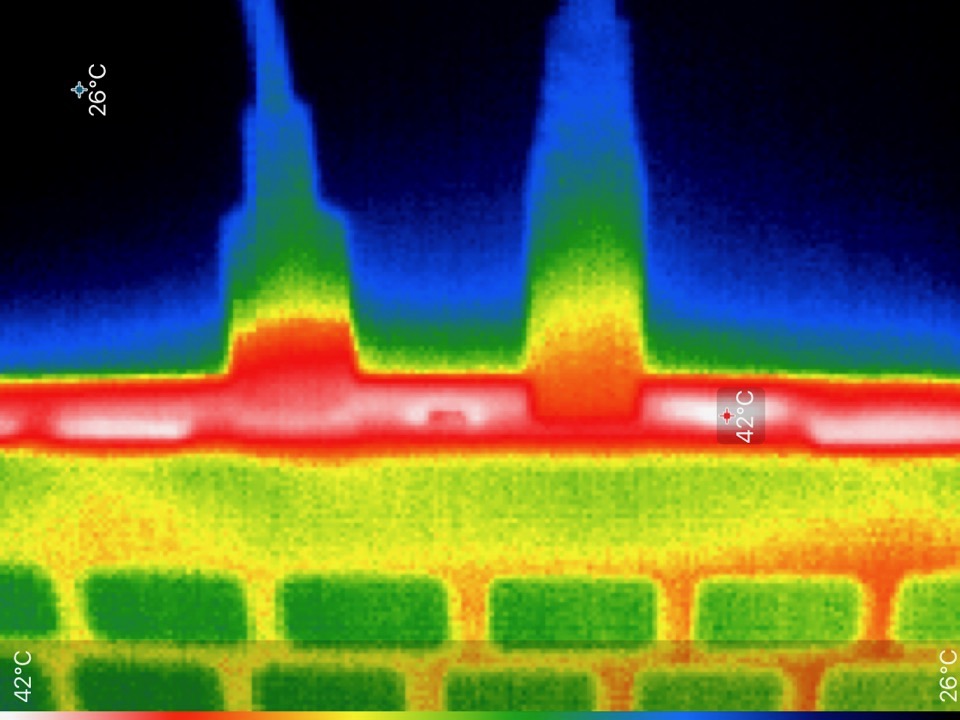
Another important difference from the Pi 4 model B: it seems like the microSD card itself doesn’t get quite as hot either (though I only measured by touch), maybe due to the fact that the SoC’s heat is transferred out more through the heat sink than the Pi’s board itself.
Intel Core i5-11600K: Platform Overview
Along with the Intel Core i5-11600K processor and ASUS ROG Maximus XIII Hero motherboard, in this guide we will be using an NVIDIA RTX 2080 Ti, a pair of G.SKILL Trident Z DDR4-4266 memory sticks, a Seasonic Prime 850W Platinum power supply, and of course EK-Quantum water cooling.
All this is mounted on top of our favorite Open Benchtable.
The cost of the components should be around $3,290
- Core i5-11600K: $310
- EK-Quantum water cooling: $400 + $200
- ASUS ROG Maximus XIII Hero: $500
- NVIDIA RTX 2080 Ti: $1300
- G.SKILL Trident Z DDR4-4266: $180
- Seasonic Prime 850W: $200
- Open Benchtable: $200
With all this in mind, let’s jump into the benchmarks and overclocking.
Cookie Run: Kingdom The Best Team Состав
| Лицевая сторона 1 | DR Dark Choco |
| Фронт 2 | DR/ATK Princess Cookie |
| Повреждение 2 | ATK Vampire Cookie/ATK Rye Cookie |
| Повреждение 3 | ATK Espresso Cookie |
| Поддержка | CD Herb Cookie CD Sparkling Cookie/CD Заварное печенье III |
Подобные отряды вы часто встретите в PVP. Понятно, почему это популярно. Он продолжает использовать проверенную стратегию «два танка впереди». Тем не менее, танки обеспечивают дополнительный укус для всей вашей команды, на этот раз снижая защиту противника. Таким образом, вы не будете полностью полагаться на эспрессо, чтобы нанести значительный ущерб.
Команда 5 Godly Hitters
< td class = «has-text-align-center» data-align = «center»> Точность 3
| Точность 1 | ATK Vampire/Adventurer |
| Precision 2 | ATK Raspberry |
| ATK/CD Red Velvet/ATK Adventurer | |
| Атака по области | ATK Any Espressolike/CD Licorice Cookie |
| Целитель | CD Pure Vanilla Cookie/ATK Herb Cookie |
Эта команда, как и предыдущая, атакует ориентированный. К счастью, игра получила несколько обновлений, которые включают больше ориентированных на убийство передних куки-файлов, которые по-прежнему достаточно прочные, чтобы выполнять работу с танком. Оба самых сильных фронта убийства — это дилеры высокоточного урона, а способность уничтожать определенные цели, такие как целители и дилеры урона, может быстро превратить битву в бойню.
Несмотря на то, что в PvP это команда по принципу «все или ничего» (ваши фронты, не являющиеся вспомогательными танками AOE, такими как Dark Choco, Moon Rabbit или Strawberry Crepe, могут вызвать проблемы, если вам не удастся убить намеченные цели), эта команда преуспевает в боях с боссами и рейд гильдии, способный нанести абсурдное количество урона, пока чистая ваниль поддерживает их жизнь.
Команда 2 Debuff Masters
| Лицевая сторона 1 | Tank Dark Choco Cookie |
| Фронт 2 | Принцесса Cookie/Tank Milk Cookie |
| Debuff 1 | ATK Cherry Cookie/ATK Tiger Lily Cookie |
| Debuff 2 | ATK Snow Sugar Cookie/ATK Cherry Cookie/ATK Tiger Lily Cookie |
| Поддержка/Исцелить | CD Custard Cookie III/CD Pomegranate Cookie |
Для очевидного причины, осыпающие врагов дебаффами имеет способность переломить плохой бой. Большой стек дебаффов часто может уравнять игровое поле против противников с более высоким рейтингом силы, чем ваша команда. Конечно, столкновение этого отряда с вражеской командой, в состав которой входят Herb Cookie или Clover Cookie (пара средств для очистки дебаффов), — это верный путь к катастрофе, поэтому избегайте этого в этом случае.
Легенды защиты Team 3
| Фронт 1 | DR Purple Yam Cookie/DEF |
| Фронт 2 | DR Knight/Milk Cookie/DEF |
| Повреждение 1 | ATK Espresso Cookie |
| Поддержка 1 | HP Licorice Cookie |
| Целитель 1 | CD Custard Cookie III/CD/ATK Herb Cookie |
Эта команда построена вокруг концепции живучесть . Два передних печенья Purple Yam и Milk Cookie предназначены для того, чтобы не подпускать злоумышленников к эспрессо.
Эспрессо под рукой, чтобы сбросить врагов в бездну с помощью вихря Grinder. Солодка присутствует, чтобы вызвать моков впереди, чтобы принять на себя основной удар атаки для остальной части группы. Заварной крем или травы присутствуют, чтобы группа оставалась здоровой и живой.
Команда 4, старая, но (золотая)
| Тактический | DEF/DR Молочное печенье/клубничное блинное печенье/эспрессоид |
| Фронт 2 | ATK/CRIT Dark Choco Cookie |
| Ущерб 1 | ATK Espressolike |
| Повреждение 2 | Солодка CD Cookie |
| Задняя опора | ATK Herb Cookie, CD Pomegranate Cookie/Pure Vanilla Cookie |
Несомненно, это образование все еще довольно эффективны в PVP и PVE, и эти топпинги обычно дополняют друг друга. Ваша типичная современная команда может последовать их примеру, заменив молоко или эспрессо эквивалентным печеньем, например, с черным изюмом или клубничным крепом. Он был обновлен, чтобы отразить добавление новых топпингов.
Это вкратце основы. Расскажите нам, что вы думаете об игре, и если вы еще не играли в нее, чего вы ждете? Играть бесплатно и легко. Продолжайте и попробуйте, а если вы обнаружите проблемы, не стесняйтесь вернуться к этому Cookie Run: Kingdom Team Building Guide Лучшие командные составы за советами!
AMD RX 5ххх and 6ххх Overclocking for Mining
Let’s see how to overclock AMD graphics cards from its new and quite effective series. Unlike Nvidia, these GPUs don’t have special smart states at the BIOS level.
So Windows doesn’t help you get a better hash rate. Furthermore, it lowers stability. It’s not surprising that most “red” miners (AMD logo is red) prefer more stable Linux-based solutions, like .
Such systems make overclocking easy.
- Overclock the memory to 900+ MHz.
- Set the core at 1350-1375 MHz.
- Lower the core voltage little by little at intervals of 5 until it remains stable. You can go as low as 800 mV for sure and you can try going lower depending on your graphics card.
- Lower the memory voltage. You can set 800 mV for sure, but if you go lower, make sure to check stability.
As a result, you maximized your hash rate and minimized consumption.
The AMD RX 5600 user provided us with overclocking instructions.
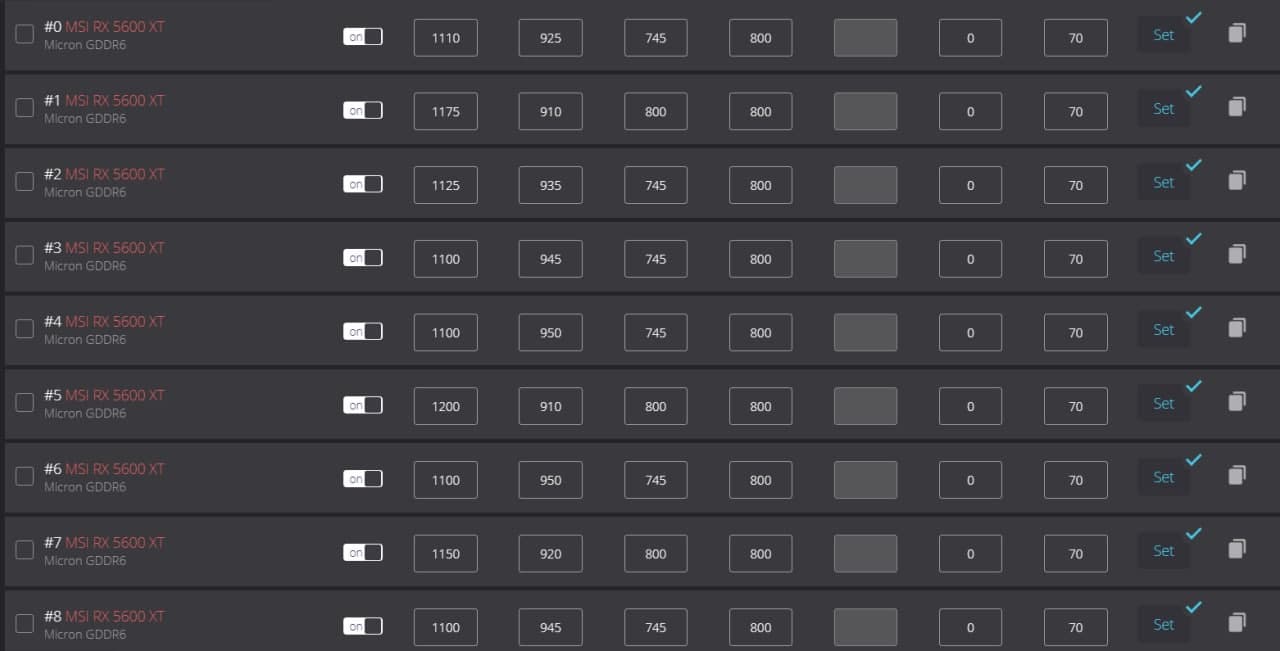
Here are the results for the RX 5600.

As for the AMD RX 5700, you can set the core at 1300-1325-1350-1375 and bring the memory to 930 and then lower at intervals of 5. If they are not stable, go down to 900. The voltage is 780.

Here are the results for the RX 5700.

Raspberry Pi 2 gpu_mem (1GB memory) allocation
gpu_mem (GPU memory) is measured in megabytes and sets the memory split between the CPU and GPU; the CPU gets the remaining memory. Minimum value is 16. If you are for example using the Raspberry Pi 2 as a gaming emulator, media player or using a desktop environment (LXDE, XFCE, Maynard, etc) then you’ll want to increase gpu_mem to at least 256. On the other hand, if you are using the Raspberry Pi as a web server, to build a drone or simply a console-based project then you should lower gpu_mem to 16. In other words, if your needs are graphical increase GPU’s memory, if not, lower it to the minimum.
eg. Web server, wireless access point, firewall, weather station, etc
gpu_mem=16
or for GUI usage, eg. OpenELEC, Raspbmc, RetroPie, XFCE, etc.
gpu_mem=320
Free Updates[]
On August 24, 2018, the New Game + update went live on Steam and was released on consoles on October 3, 2018. It added a new 4-star difficulty option and made some changes to Story Mode and the World Map.
On December 14, 2018, the Kevin’s Christmas Cracker update went live on Steam. It added 5 more levels, 2 new recipes, and practice mode.
On February 5th, 2019, the Chinese New Year Update went live on Steam. It added 7 new levels, 2 new recipes, and survival mode.
On December 17th, 2019, the Winter Wonderland update went live on all platforms. It added 5 seasonal levels from the 2019 DLC (one from Campfire Cook Off, two from Night of the Hangry Horde and two from Carnival of Chaos), 2 new chefs, Horde Mode, and 5 seasonal recipes.
On January 23rd, 2020, the Spring Festival update went live on all platforms except Xbox. It added 5 new levels, along with two new chefs (the rat and turtle).
On July 5th, 2020, the Sun’s Out Bun’s Out went live on Steam. It was released on consoles on July 16th, 2020. It added 5 new levels, 2 new recipes, and two new chefs.
On October 1st 2020, the Moon Harvest update went live on Steam. It added 5 new levels, 1 new recipe (with 3 variations) and a new kitchen hazard.
Intel Rocket Lake Overview
Intel’s 11th generation Core products for desktop, codenamed Rocket Lake, were officially introduced by Intel during the CES 2021 tradeshow in January and arrived to the market in March 2021.
Rocket Lake is the successor to Intel’s 10th generation Comet Lake processors. Rocket Lake sports a brand new CPU core architecture while still on the vastly improved 14nm process node. The CPU core is built upon the Cypress Cove architecture which is the backported version of Sunny Cove, a core designed for 10nm Ice Lake, with some additional performance improvements.
Due to the increased core size, the flagship Core i9-11900K offers up to 8 cores and 16 threads compared to its Core i9-10900K predecessor’s 10 cores and 20 threads. The Core i5 offer is still 6 cores and 12 threads. Rocket Lake CPUs do gain support for deep learning boost and AVX-512 instructions, a new and improved cache hierarchy, and up to 19% instructions per clock improvement.
Other new features include slightly elevated default memory support up to DDR4-3200, 20 PCIe 4.0 lanes from the CPU, doubled bandwidth of the DMI link, and moving the integrated graphics to the new Xe graphics architecture.
The Turbo Boost frequencies of the flagship processor are identical to the 10900K. So, we’ll see a base frequency of 3.5GHz, an all-core turbo of 4.8GHz, and a maximum thermal velocity boost frequency of 5.3GHz.
Compared to the 10600K, the 11600K has a 200MHz lower base frequency of 3.9GHz while offering a 100MHz higher maximum boost frequency of 4.9 GHz. For the i5-11600K processor, the long-term TDP is still 125W while the CPU can boost to 180W temporarily if sufficient turbo budget is available.
Rocket Lake will work on both 500 series and 400 series motherboards, though not on B460 or H410. Obviously that means Rocket Lake fits in the LGA1200 socket.
Features[]
- Online multiplayer! For the first time, you can cook up a storm with up to four players in both local and online multiplayer!
- Throwing! Throwing is now an official game mechanic, allowing you to toss ingredients to your fellow chefs or even straight into the pan/blender/onto the floor!
- New level mechanics! Overcooked 2 sees the introduction of new game mechanics including moving walkways, controllable platforms, and even portals!
- Dynamic levels! Throwing you from the frying pan and into the fire, dynamic levels will change around you, offering a new challenge to overcome as the recipes and levels themselves change!
- Interactive world map! As you drive, sail and soar your way around the map in the Onion King’s amphibious air bus you will open up new areas using hidden buttons around the world!
- Kitchens! From the neon lights of a sushi restaurant to the bubbling pots of a Wizard school kitchen, there are plenty of places to cook up a storm in Overcooked 2!
- Recipes! From spaghetti to sushi and pancakes to pizza, recipes both old and new will need to be cooked to perfection (or at least not burnt to a crisp!) New recipes mean new ingredients and new equipment so even the most well-seasoned Overcooked players will be challenged!
- Chefs! Overcooked 2 introduces a whole host of new of chefs to play in the kitchen including an eagle, mouse, beaver and what kitchen is complete without an octopus!
Energy Efficiency in Mining. Operating modes
Any GPU can operate in power saving mode, but overclocking allows you to maximize hash rate. At the same time, energy efficiency suffers.
![]()
You can save the results as links to 2CryptoCalc that allows you in just a few clicks to evaluate whether your algorithm is better or worse than alternatives in terms of the current mining profitability specifically for your rigs.
Electricity costs and current profit are crucial when you are choosing an algorithm and rig operating mode.
Max Energy Efficiency and New Rigs
Sooner or later, all miners end up estimating max hash rate per 1 kW of a rig power due to either electricity cost or the limit of “free” power.
Here are max hash rates adjusted for the dev fee per 1 kW of utility power with Platinum PSUs for the 10xx, 20xx and 30xx series.

* – The 30xx series stats are up-to-date as of December 25, 2020.
As you can see the 20xx series has a marginal benefit per 1 kW 1.5x higher than the previous one. It’s mainly due to the enhanced memory access algorithm. For algorithms that mostly use the GPU core the result is less impressive – 33%.
Introduction
The Intel Core i5-11600K is the little brother of the overclockable Rocket Lake K-sku CPUs. It is the successor of the i5-10600K which we overclocked once before to 5.2 GHz, also with a Maximus Hero motherboard.
The Core i5-11600K offers 6 cores and 12 threads with a listed base frequency of 3.9 GHz and a listed boost frequency up to 4.9 GHz. It is rated at 125W TDP and should retail at an MSRP of $310.
The ASUS ROG Maximus XIII Hero is the successor to the ASUS ROG Maximus XII Hero motherboard we featured in a previous overclocking video. It is the entry level offer in the ASUS ROG line up and offers plenty of overclocking features such as 14+2 power stages, the ROG water-cooling zone, a debug code display, as well as AI overclocking and memtest86 integrated in the BIOS.
In this video we will cover the basic overclocking steps to get your CPU all the way to 5.1 GHz using custom loop water cooling.
We will dig into four overclocking strategies.
- First, we will unlock all the power limits and enable XMP
- Second, we will use the package temperature threshold AI feature to push the CPU frequency up.
- Third, we will allow the motherboard to do its thing and overclock using AI overclocking.
- Lastly, we’ll do some manual overclocking.
Before we jump into the overclocking, let’s talk a little bit more about Rocket Lake and the hardware we’ll be using in this guide.
Description[]
The Onion Kingdom is in peril again but this time, the Onion King himself is to blame. After reading aloud from the fabled Necro-nomnom-icon, he has cooked up a whole new problem in the form of an Undead Bread army called The Unbread. Players will need to chop, fry, and bake their way through all-new crazy kitchens to defeat this new foe and save the kingdom once more.
Overcooked! 2 is a game for 1-4 players. Play solo or team up with friends either local on the couch or online and cook up a ton of brand new recipes. Overcome obstacles such as fire, collapsing floors, overbearing waiters, and floating work surfaces.
Raspberry Pi 2 Overclock options
- arm_freq– Frequency of ARM in MHz. (Raspberry Pi 2 Overclock)
- core_freq -Frequency of GPU processor core in MHz. It has an impact on ARM performance since it drives L2 cache.sdram_freq -Frequency of SDRAM in MHz.
- over_voltage – ARM/GPU core voltage adjust. Values above 6 are only allowed when force_turbo or current_limit_override are specified (which set the warranty bit).
- force_turbo – Disables dynamic cpufreq driver and minimum settings below. Voids Warranty.
- initial_turbo -Enables turbo mode from boot for the given value in seconds (up to 60) or until cpufreq sets a frequency. Default 0
- arm_freq_min – Minimum value of arm_freq used for dynamic clocking.
- core_freq_min – Minimum value of core_freq used for dynamic clocking.
- sdram_freq_min – Minimum value of sdram_freq used for dynamic clocking.
- temp_limit – Overheat protection. Sets clocks and voltages to default when the SoC reaches this Celsius value. Setting this higher than default voids warranty. Default 85
- disable_splash – If set to 1, avoids the rainbow splash screen on boot.
- boot_delay – Wait for x number of seconds in start.elf before loading kernel. Default 1
- gpu_mem – GPU memory in megabyte. Sets the memory split between the ARM and GPU. ARM gets the remaining memory.
Thermal Performance at 1.8 GHz
A few other reviewers did some tests (like Explaining Computers) and found the Pi 400 was able to stay cooler than a Pi 4 inside a Flirc passive heat sink case, but was not quite as cool as a Pi 4 running with an ICE cooling tower.
I wanted to see if there’s any level at which the CPU gets near throttling, so I set up a test scenario and started measuring temperatures, both internally and with my Seek IR camera.
I took a thermal image of the board before running any tests:

At idle, the exterior of the keyboard is indistinguishable from the environment around it. Plastic isn’t the best thermal conductor, and later I found that most of the heat output goes through the ports in the back and the vent on the bottom.
And then I started dumping temperature data into a CSV file with the command:
I kicked off to load up all the four CPU cores on the Pi, and let it run for 30 minutes at the default 1.8 GHz clock on the Pi 400:
And here’s a graph of the temperature over 30 minutes:
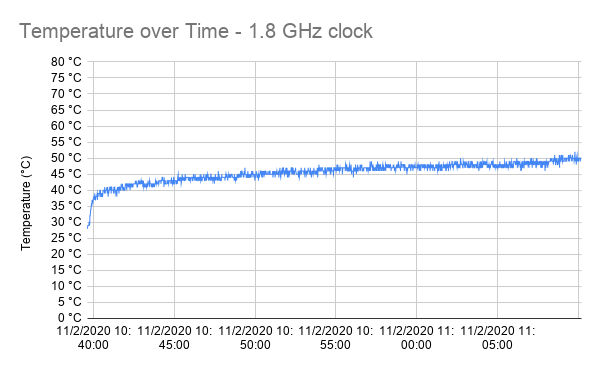
The maximum temperature it reached was 52°C, though the surface of the keyboard never went above 31°C:
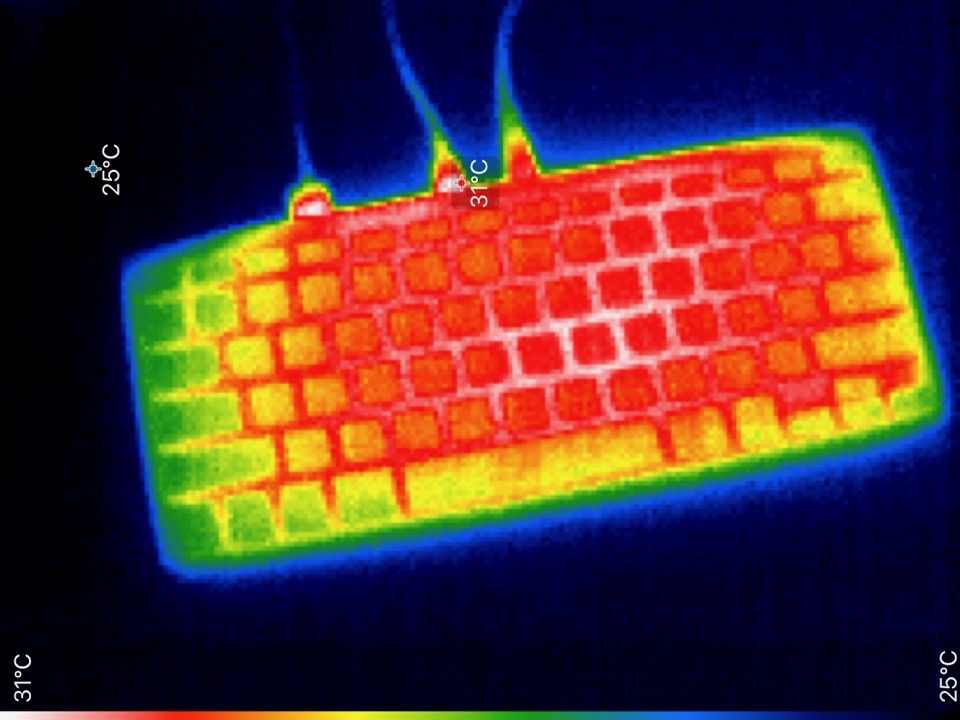
The bottom was very slightly warm, and the ports on the back were warm to the touch, but not even close to the painful ‘ouch’ I would get touching some parts on the Pi 4 under load!
Other ways to play with friends
Although PlayStation, Xbox, and Nintendo console owners cannot play with friends on other consoles, they are able to play online co-op with anybody who owns Overcooked on the same console as them.
Alternatively, Overcooked 2 can be enjoyed locally with up to four people, as long as there are enough controllers to go around. The game also includes a feature that lets two people control two different characters with the one controller. Switch users already have two controllers with the joycons, so this feature is unfortunately not included with the Pro Controller or Switch Lite.
Players can even combine online and local co-op to play with those in the same household as them, and with friends elsewhere.
OC Strategy #1: Unlocked the Power Limits & XMP
Any aspiring overclocker should be aware of the Intel Turbo Boost 2.0 technology. Turbo Boost 2.0 enables higher CPU performance in situations where there is sufficient current, power, and temperature headroom.
The long story short is that Turbo Boost 2.0 allows the processor to operate at increased power consumption temporarily above the TDP rating to achieve higher performance. It manages this by accumulating “energy budget” during periods of idle time that can be deployed when necessary during periods of high load.
We discussed the Intel Turbo Boost 2.0 Technology at length in a previous video titled “Intel Turbo Boost 2.0 & Intel Turbo Boost Max 3.0 Explored”. While we use a different CPU, the Turbo Boost principles explained in that video also apply to our configuration.
By unlocking all the power limits, we effectively tell the CPU to run at the highest possible turbo boost settings all the time.
As we mentioned before, on the Maximus XIII Hero the power limits are unlocked by default. So all we need to do is load the optimized defaults and the power limits are unlocked.
We also enable XMP.
XMP stands for Extreme Memory Profile. It allows memory vendors such as Gskill to program higher performance settings onto the memory sticks. If the motherboard supports XMP, then you can enable the higher performance with a single BIOS setting. So it saves you from lots of manual configuration.
We discussed the Intel XMP Technology at length in a previous video titled “Intel Extreme Memory Profile Explained”. Check it out if you want additional information.
Upon entering the BIOS
- Go to the Extreme Tweaker menu
- Set AI Overclock Tuner to XMP I
- Set ASUS MultiCore Enhancement to Enabled – Remove All Limits
Then save and exit the BIOS.
We re-ran the benchmarks and checked the performance increase compared to default operation.

As expected, the performance uplift is most notable in multi-threaded benchmark applications which would typically be heavily constraint by the default power limits.

When running Prime 95 Small FFT with AVX enabled, the Core i5-11600K operates stably at 4.6 GHz with 1.301 volt. The average CPU temperature is 79 degrees centigrade, the average VRM temperature is 40 degrees centigrade, and the average water temperature is 25 degrees centigrade. The average CPU package power is 216 watt.
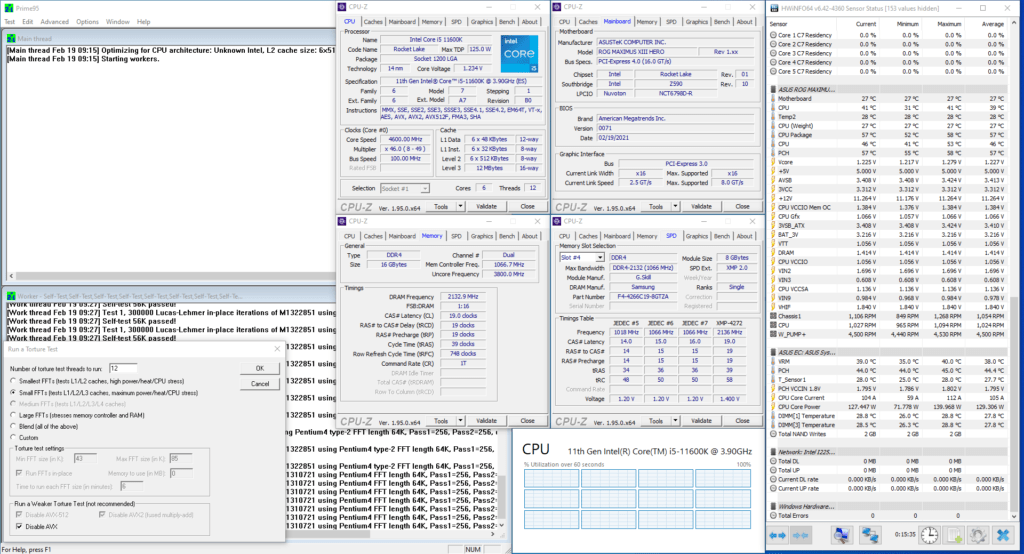
When running Prime 95 Small FFT with AVX disabled, the Core i5-11600K operates stably at 4.6 GHz with 1.227 volt. The average CPU temperature is 57 degrees centigrade, the average VRM temperature is 35 degrees centigrade, and the average water temperature is 28 degrees centigrade. The average CPU package power is 150 watt.
Anyway, let’s do manual overclocking.
Before you get started, make sure to identify the clear CMOS button on the IO panel. In case your system doesn’t boot up after trying overclocked settings, you can press this button to start from scratch.



